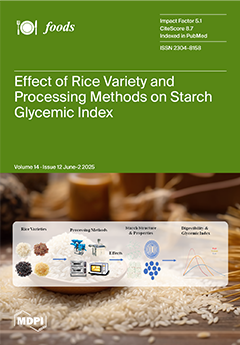In this study, the impacts of traditional processing on phytates contents, phytate: mineral molar ratios, and the bioaccessibility of calcium, iron, and zinc in three traditional
koko production units (KP1, KP2, and KP3) and two
zoomkoom production units (ZP1 and ZP2) products were
[...] Read more.
In this study, the impacts of traditional processing on phytates contents, phytate: mineral molar ratios, and the bioaccessibility of calcium, iron, and zinc in three traditional
koko production units (KP1, KP2, and KP3) and two
zoomkoom production units (ZP1 and ZP2) products were assessed based on the variations in their traditional processing techniques. The total calcium content of ZP1 was ranked the highest (58.02 mg/100 g,
p < 0.05) compared to other processed samples. A high total value of iron (17.76 mg/100 g,
p < 0.05) was revealed among
koko compared to
zoomkoom. Whereas KP3 and ZP2 showed the highest (
p < 0.05) amount of zinc (3.34 mg/100 g). ZP1 showed a calcium bioaccessibility of 6.3% (
p < 0.05). The iron bioaccessibility was within the average range of 5–30%, with KP1 ranking the highest (21.8%), while ZP1 showed the highest value (42.2%) (
p < 0.05) in bioaccessibility of zinc among the
zoomkoom products. The processing techniques adopted caused up to a 56.7% to 76.76% reduction (
p < 0.05) of phytic acid in the pearl millet, leading to a decrease in the molar ratios of [Ca]:[Phy], [Fe]:[Phy], and [Phy]:[Zn]. However, the phytic acid content varied among the
koko and
zoomkoom, corresponding with the varied inhibitory mechanism indices reported. In brief, a positive correlation was shown between the traditional processing techniques, phytate, and in vitro bioaccessibility of minerals, indicating the consumption of
koko and
zoomkoom as a good source of functional minerals.
Full article






